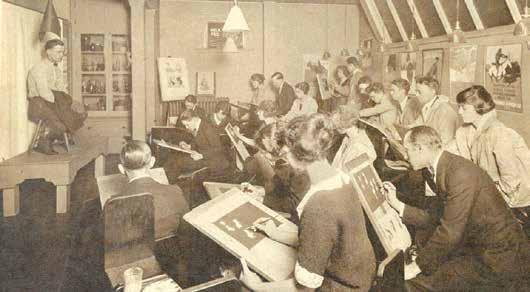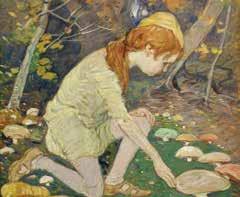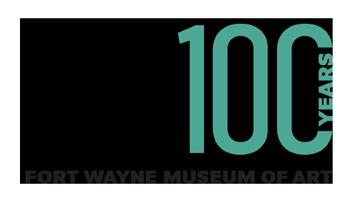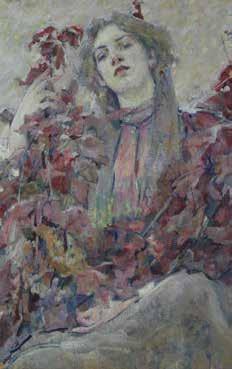
5 minute read
fort wayne museum of art 100th anniversary
Fort Wayne MuseuM of Art celebrates its 100th anniversary
story by Julie Campbell
CouNtERCloCkwiSE: Fort wayne Art institute figure drawing class, 1920s
theodore F. thieme, 1926
Alice Neel visit, 1979
Fort wayne Art School students, 1970s

A lot can happen in 100 years. Babies born. Leaders buried. Wars and rumors of wars. Economic booms and banes. Inventions. Advances in science. Art. Life.
In the last century, Fort Wayne Museum of Art (FWMoA) has seen it all. Shortly before its opening in 1921, the world had just recovered from the Spanish Flu pandemic. Now, during its 100-year celebration, society is in the middle of another pandemic. But that hasn’t stopped the museum from celebrating, both virtually and safely in person.
For 18 of the past 100 years, Charles Shepard III has served as president and CEO of the FWMoA. An artist himself, Shepard grew up in Maine, where many artists would spend the summer to get away from city life.
“I didn’t grow up in an artistic family. As a kid, I would mow lawns for artists in the summer,” he recalls. “And one of them asked me, ‘Do you know how to stretch a canvas?’”
From that moment on, Shepard was hooked.
“Once I got into art, it was a real driving thing for me,” he says, recalling how he would put art shows together and display them in coffee houses. “I realized if you could show someone art that delights them, you could win them over.”
That philosophy is what drives Shepard as he leads the museum through the next century.
“We’re curating with that person in mind who thinks they don’t like art,” he explains with evident excitement and passion in his voice. “You don’t have to dress up and know anything special. Just come in and see if you like it!”
Originally starting out as an art school, the function of museum was added to the school when a collection of ten paintings was donated by Theodor Thieme, a prominent Fort Wayne citizen.
Although times have changed since Thieme’s donation, the basic principles on which the museum was founded remain the same.
“The museum exists to collect, preserve, educate, and exhibit,” says Shepard. “Those principles have been challenged over the years, but when you
get right down to it, that’s what it’s about. We’re still faithful to those four principles.”
A special exhibit entitled “A Century of Making Meaning: 100 Years of Collecting,” gives visitors a glimpse into each decade of the museum’s collecting history by presenting objects acquired by decade on a rotating basis.
Another one of the unique ways the museum is celebrating its 100th year is by giving gifts of art to 100 other museums around the country.
“David Shapiro was an artist-inresidence at Fort Wayne Museum of Art in the 80s,” Shepard says. “After his death, his widow donated 840 works— the largest collection of his work in the country—to us. And now we’re sharing it with other museums.”
In the next century, Shepard said the museum also plans to expand its already extensive collection of glass, which includes pieces by world famous glass artist Dale Chihuly.
“Glass is going to be even bigger,” he explains. “The goal is to have a collection that will make us a center for contemporary glass—we really want to be known for glass.”
According to Amy Schreiber, the museum’s director of executive initiatives, a special outdoor public sculpture by Indiana-based sculptor Dale Enochs, is being commissioned to celebrate the anniversary.
“We are expecting to unveil the sculpture in August,” she says. “It will speak to the role of the three major rivers (today called the St. Joseph, St. Mary’s, and Maumee) in our city’s development, and also honor the rivers as they were originally named and used by the Miami people of this area.”
Other 100th anniversary events are membership giveaways, virtual exhibition tours, virtual events by staff featuring items from the collection and a special installation by Vincennes-based artist Fernando Lozano for the annual Dia de los Muertos event, and the 100th Celebration Finale on March 4, 2022.
“What I find most rewarding is being a part of an organization with such deep historical roots to the local community,” said Schreiber. “Fort Wayne is a community who values arts and culture, and we see that it plays a vital role in the very bright future of Fort Wayne— exciting things are on the horizon for this community and the arts will certainly be included. Fort Wayne is the little city that could, and we are proving that with each passing day.”



Eleanor Brockenbrough, Drying the Nets, ca. 1900, oil on board. Purchase, 1925.05.
william Forsyth, Fairy Ring, ca. 1900, gouache, watercolor, and graphite on paper board. Gift of Eleanor A. Golden, 2002.07.
Robert Reid, Defiant Autumn, ca. 1900, oil on canvas. Gift of John Herron Art School, 1958.03.
If you go…
Fort Wayne Museum of Art 311 E. Main Street, Fort Wayne, Indiana
Gallery hours are:
Sunday, 12-5 p.m. Tuesday – Saturday, 10 a.m. to 6 p.m. Thursday, 10 a.m. to 8 p.m. Galleries are closed Mondays and major holidays. Masks and social distancing required.
General admission:
Free to members $8, adults $6, students (preK through college) $6, seniors (ages 65 and up) $20, families Free admission every Thursday from 5 to 8 p.m.
For more information, visit fwmoa.org.











